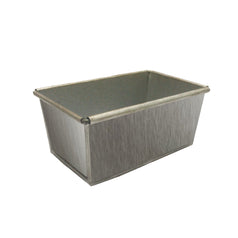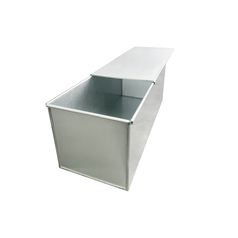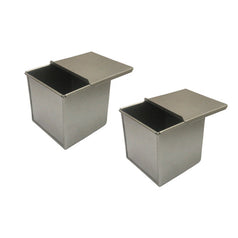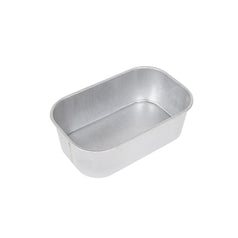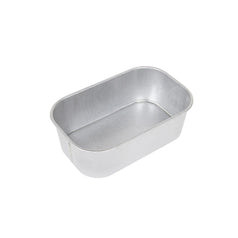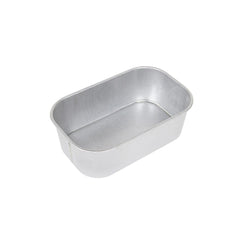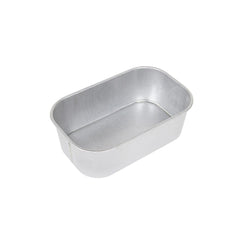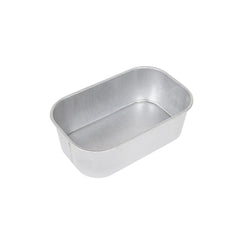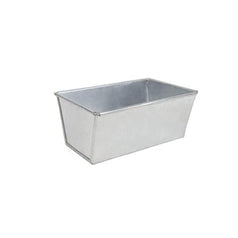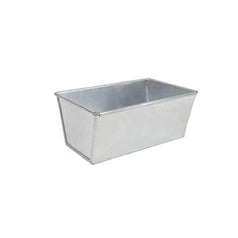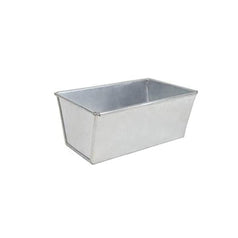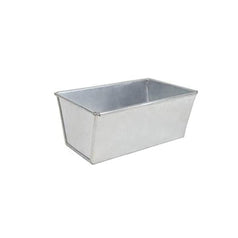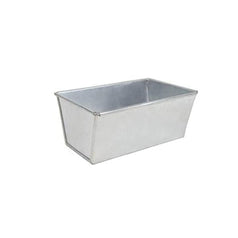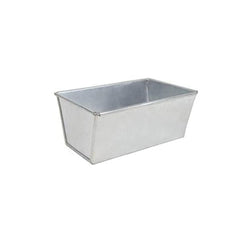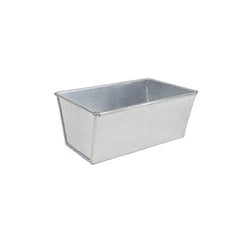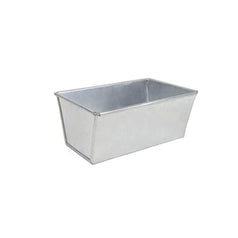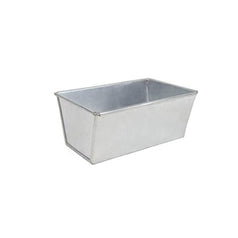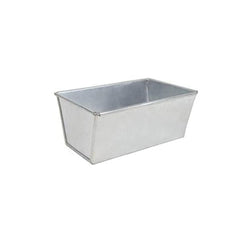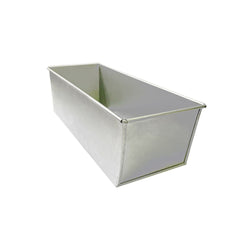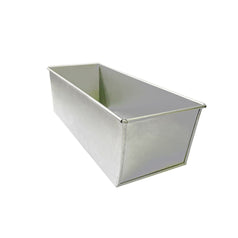-
Singles Loaf Tin Bread Pan Commercial Bakery by EUROTINS
Regular price From £4.99Regular priceUnit price per -
EUROTINS Pullman Loaf Bread Tin with Lid
Regular price From £11.99Regular priceUnit price per£12.99Sale price From £11.99 -
Set Of 2 Pullman Cube Tin with Lid 10cm x 10 cm x 10 cm
Regular price £9.90Regular priceUnit price per£12.99Sale price £9.90 -
400 gm Farmhouse Loaf Bread Tin 175 x 122 x 77 mm
Regular price £6.99Regular priceUnit price per -
400 gm Farmhouse Loaf Bread Tin 160 x 110 x 70 mm
Regular price £6.99Regular priceUnit price per -
250 gm Farmhouse Loaf Bread Tin 135 x 95 x 68 mm
Regular price £4.99Regular priceUnit price per -
800 gm Farmhouse Loaf Bread Tin 255 x 140 x 80 mm
Regular price £8.99Regular priceUnit price per -
800 gm Farmhouse Loaf Bread Tin 255 x 140 x 80 mm
Regular price £8.99Regular priceUnit price per -
800 gm Tappered Bread Tin - 230 x 117 x 110 mm
Regular price £8.99Regular priceUnit price per -
400 gm Tappered Bread Tin - 160 x 105 x 89 mm
Regular price £5.99Regular priceUnit price per -
400 gm Tappered Bread Tin - 170 x 96 x 83 mm
Regular price £5.99Regular priceUnit price per -
400 gm Tappered Bread Tin - 170 x 96 x 83 mm
Regular price £5.99Regular priceUnit price per -
400 gm Tappered Bread Tin - 155 x 102 x 80 mm
Regular price £8.99Regular priceUnit price per -
800 gm Tappered Bread Tin - 248 x 120 x 117 mm
Regular price £8.99Regular priceUnit price per -
400 gm Tappered Bread Tin - 155 x 102 x 80 mm
Regular price £5.99Regular priceUnit price per -
800 gm Tappered Bread Tin - 230 x 120 x 118 mm
Regular price £8.99Regular priceUnit price per -
800 gm Tappered Bread Tin - 269 x 114 x 102 mm
Regular price £8.99Regular priceUnit price per -
800 gm Tappered Bread Tin - 308 x 102 x 100 mm
Regular price £8.99Regular priceUnit price per -
500 gm Square Side Bread Tin - 250 x 100 x 100 mm
Regular price £4.99Regular priceUnit price per -
800 gm Square Side Bread Tin - 360 x 100 x 100 mm
Regular price £6.99Regular priceUnit price per
Baking homemade bread is an art that requires the right tools to achieve perfect results. One of the most essential tools in your baking arsenal is the bread tin. This comprehensive guide will help you navigate through the various types of bread tins, their materials, and tips for choosing and maintaining the perfect bread tin to elevate your baking experience.
Types of Bread Tins
Bread tins, also known as loaf pans, come in different shapes and sizes to cater to various baking needs. Here are the most common types:
Standard Loaf Tins
These are the most commonly used bread tins, typically rectangular and available in a range of sizes. They are ideal for baking traditional loaves of bread, meatloaf, and pound cakes.
Pullman Loaf Tin
Also known as pain de mie pans, these tins have a lid that creates a square loaf with flat sides and a consistent crumb. They are perfect for sandwich bread and other recipes requiring a uniform shape.
Mini Loaf Tins
Mini loaf tins are smaller versions of standard loaf tins, perfect for individual servings or gift-sized loaves. They are great for baking multiple small loaves simultaneously.
Specialty Loaf Tins
These tins come in various shapes and designs, such as heart-shaped or star-shaped tins, adding a unique touch to your baked goods. Specialty loaf tins are perfect for themed baking and special occasions.
Materials
The material of your bread tin significantly impacts the baking process and the quality of your bread. Here are the most common materials used for bread tins:
Aluminum
Aluminum bread tins are popular due to their excellent heat conductivity, ensuring even baking. They are lightweight, resistant to rust, and available in both plain and non-stick finishes. However, aluminum can react with acidic ingredients, which might affect the taste of your bread.
Stainless Steel
Stainless steel bread tins are durable, non-reactive, and resistant to rust and warping. While they may not conduct heat as efficiently as aluminum, they are preferred for their longevity and ability to withstand high temperatures.
Non-stick Coated
Non-stick coated bread tins are usually made of aluminum or steel with a non-stick coating, making it easy to release bread without sticking. They require gentle handling to avoid scratching the surface and compromising the non-stick properties.
Silicone
Silicone bread tins are flexible, non-stick, and easy to clean. They are perfect for easy release of baked goods and are safe for use in the oven, microwave, and freezer. However, they do not provide the same crisp crust as metal tins.
Glass
Glass bread tins are great for baking and serving, as they can go from oven to table. They retain heat well and allow you to monitor the baking process. However, glass is heavy and can break easily if not handled carefully.
Choosing the Right Size
Selecting the appropriate size of bread tin is crucial for achieving the best results. Here are some standard sizes and their uses:
Small Loaf Tin
Ideal for smaller loaves, quick breads, and pound cakes. This size is perfect for recipes yielding 1 to 1.5 pounds of dough.
Medium Loaf Tin
This is the most common size, suitable for standard bread recipes. It can accommodate 1.5 to 2 pounds of dough, making it ideal for most home bakers.
Large Loaf Tin
Perfect for larger recipes or those that require more rising space. This size is great for recipes yielding 2 to 3 pounds of dough.
Features to Consider
When choosing a bread tin, consider the following features to ensure optimal performance and durability:
Thickness
Thicker tins provide better heat distribution and are less likely to warp. Look for tins with a thickness of at least 0.8mm to ensure durability and even baking.
Handles
Handles or extended edges make it easier to maneuver the tin in and out of the oven. Ensure the handles are sturdy and provide a secure grip.
Non-stick Coating
Non-stick coatings facilitate easy release of the bread and simplify cleanup. However, they require careful handling to avoid scratches and damage.
Ease of Cleaning
Consider tins that are dishwasher-safe or easy to clean by hand. Non-stick and silicone tins are generally easier to clean, but stainless steel and aluminum tins can handle more robust cleaning methods.
Tips for Using and Maintaining Your Bread Tin
Preheat the Tin
Preheating your bread tin can help ensure even baking and prevent sticking. Place the tin in the oven while it preheats to achieve consistent results.
Grease the Tin
Even with non-stick tins, it's a good idea to grease the tin lightly with butter or oil to ensure easy release of the bread. For added insurance, line the tin with parchment paper.
Avoid Metal Utensils
Using wooden or silicone utensils can help avoid scratching non-stick surfaces. Metal utensils can damage the coating and reduce the lifespan of your bread tin.
Regular Cleaning
Clean your bread tin after each use to prevent the buildup of grease and food residue. Avoid using abrasive cleaners or scouring pads, especially on non-stick surfaces.
Store Properly
Store your bread tins in a dry place to prevent rust and damage. Stacking tins with protective layers, such as paper towels, can prevent scratches and prolong their lifespan.
Conclusion
Choosing the right bread tin involves understanding the various types, materials, and features available. By selecting a high-quality bread tin that suits your specific needs, you can enhance your baking experience and achieve perfect results every time. Whether you're baking a simple loaf or an elaborate specialty bread, the right bread tin will make the process easier and more enjoyable.




